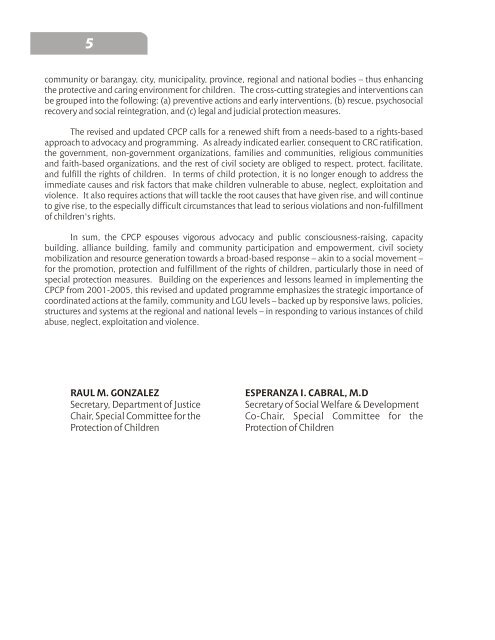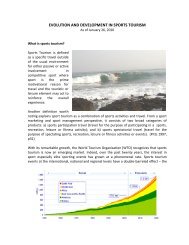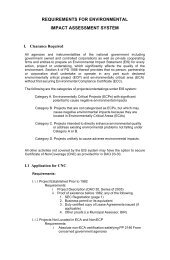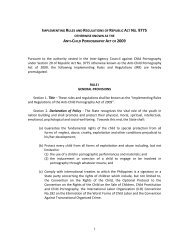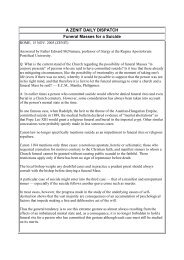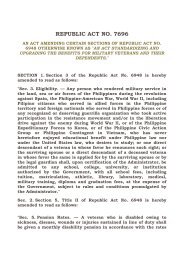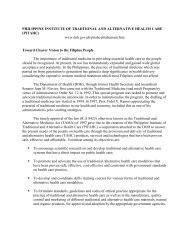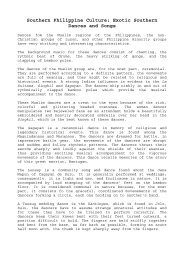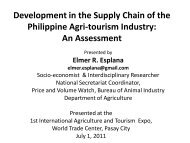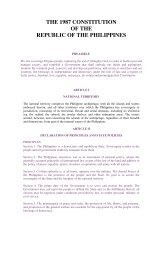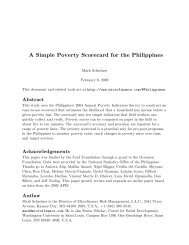protecting filipino children from abuse, exploitation and violence
protecting filipino children from abuse, exploitation and violence
protecting filipino children from abuse, exploitation and violence
Create successful ePaper yourself
Turn your PDF publications into a flip-book with our unique Google optimized e-Paper software.
5<br />
community or barangay, city, municipality, province, regional <strong>and</strong> national bodies – thus enhancing<br />
the protective <strong>and</strong> caring environment for <strong>children</strong>. The cross-cutting strategies <strong>and</strong> interventions can<br />
be grouped into the following: (a) preventive actions <strong>and</strong> early interventions, (b) rescue, psychosocial<br />
recovery <strong>and</strong> social reintegration, <strong>and</strong> (c) legal <strong>and</strong> judicial protection measures.<br />
The revised <strong>and</strong> updated CPCP calls for a renewed shift <strong>from</strong> a needs-based to a rights-based<br />
approach to advocacy <strong>and</strong> programming. As already indicated earlier, consequent to CRC ratification,<br />
the government, non-government organizations, families <strong>and</strong> communities, religious communities<br />
<strong>and</strong> faith-based organizations, <strong>and</strong> the rest of civil society are obliged to respect, protect, facilitate,<br />
<strong>and</strong> fulfill the rights of <strong>children</strong>. In terms of child protection, it is no longer enough to address the<br />
immediate causes <strong>and</strong> risk factors that make <strong>children</strong> vulnerable to <strong>abuse</strong>, neglect, <strong>exploitation</strong> <strong>and</strong><br />
<strong>violence</strong>. It also requires actions that will tackle the root causes that have given rise, <strong>and</strong> will continue<br />
to give rise, to the especially difficult circumstances that lead to serious violations <strong>and</strong> non-fulfillment<br />
of <strong>children</strong>'s rights.<br />
In sum, the CPCP espouses vigorous advocacy <strong>and</strong> public consciousness-raising, capacity<br />
building, alliance building, family <strong>and</strong> community participation <strong>and</strong> empowerment, civil society<br />
mobilization <strong>and</strong> resource generation towards a broad-based response – akin to a social movement –<br />
for the promotion, protection <strong>and</strong> fulfillment of the rights of <strong>children</strong>, particularly those in need of<br />
special protection measures. Building on the experiences <strong>and</strong> lessons learned in implementing the<br />
CPCP <strong>from</strong> 2001-2005, this revised <strong>and</strong> updated programme emphasizes the strategic importance of<br />
coordinated actions at the family, community <strong>and</strong> LGU levels – backed up by responsive laws, policies,<br />
structures <strong>and</strong> systems at the regional <strong>and</strong> national levels – in responding to various instances of child<br />
<strong>abuse</strong>, neglect, <strong>exploitation</strong> <strong>and</strong> <strong>violence</strong>.<br />
RAUL M. GONZALEZ<br />
Secretary, Department of Justice<br />
Chair, Special Committee for the<br />
Protection of Children<br />
ESPERANZA I. CABRAL, M.D<br />
Secretary of Social Welfare & Development<br />
Co-Chair, Special Committee for the<br />
Protection of Children


